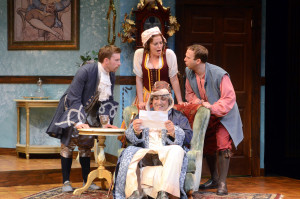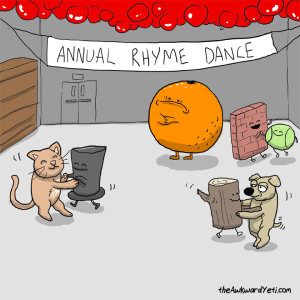Official Blog of International City Theatre
Diary of an ICT Intern: Rhyme Time
July 1st, 2015
International City Theatre is excited to introduce Amy Patton, our Summer Administrative and Production Intern. She will be working with us this summer thru the Los Angeles County Arts Commission Internship program, and will be producing a Blog series entitled “Diary of an ICT Summer Intern.â€
What is in a rhyme? Well, a word ending in any other sound wouldn’t be as sublime.
Of course we’re all well-rehearsed in Dr. Seuss and Mother Goose. Thus we have a basic understanding of what rhyming actually is. But what does it take to be a professional rhyming whiz?

Wallace Angus Bruce, Matthew Henerson, Paige Lindsey White & Adam J. Smith in THE HEIR APPARENT. Photo Credit: Suzanne Mapes
Originating with the Chinese, rhymes and literature go way back, roughly 30 centuries to be exact. The word itself derives from Old French, rime or ryme, meaning “series or sequence.†In modern language, rhymes frequented the works of greats like Shakespeare, Dickinson and Poe. As the years go by, the adoration of rhyming continues to grow.
French Farce Le Légataire Universel might not ring a bell, but David Ives’ translaption is a story to tell. The Heir Apparent, ICT’s latest play, slays the poetic phonetic aesthetic, taking advantage of the classic couplet a couple of times.
Now pause — let’s take a minute to break down the basics of rhyming for those new to poetics and rhyme. Below are some common and simple terms, definitions and examples of different types of rhymes.
Couplet (n.) – a pair of successive lines that rhyme and have the same meter.
Ex) Humpty Dumpty sat on a wall/Humpty Dumpty had a great fall
End Rhyme (n.) – When the words at the end of lines rhyme.
Ex) A word is dead/when it is said
Feminine rhyme (n.) – rhyming unstressed syllables
Ex) Dicing/Enticing
Masculine Rhyme (n.) – rhymes ending in a stressed syllable
Ex) Hell/Bell
Slant Rhyme (n.) — formed by words with similar but not identical sounds. Usually, either the vowel segments are different while the consonants are identical, or vice-versa.
Ex) Tell/Toll
Internal Rhyme (n.) Â — When a word in the middle of a single line rhymes with the end word.
Ex) Once upon a midnight dreary, while I pondered, weak and weary
Now that a few things have been defined, you can see there’s a myriad of ways to rhyme. The Heir Apparent implements many couplets in its lines to keep the meter in time. But every once in a while the script breaks pattern. So, by keeping these other rhyme-based devices in its arsenal, the play doesn’t allow for one word to go to waste.
Seeing a play with a methodic rhyme scheme makes the writing snappy and clever. So, when contemplating a play, never say never to rhyme. The Heir Apparent runs through the twelfth of July. Buy a ticket and give rhymes a try. If you have any questions at all, give us a call at (562) 436-4610 or go online to www.ictlongbeach.org.
